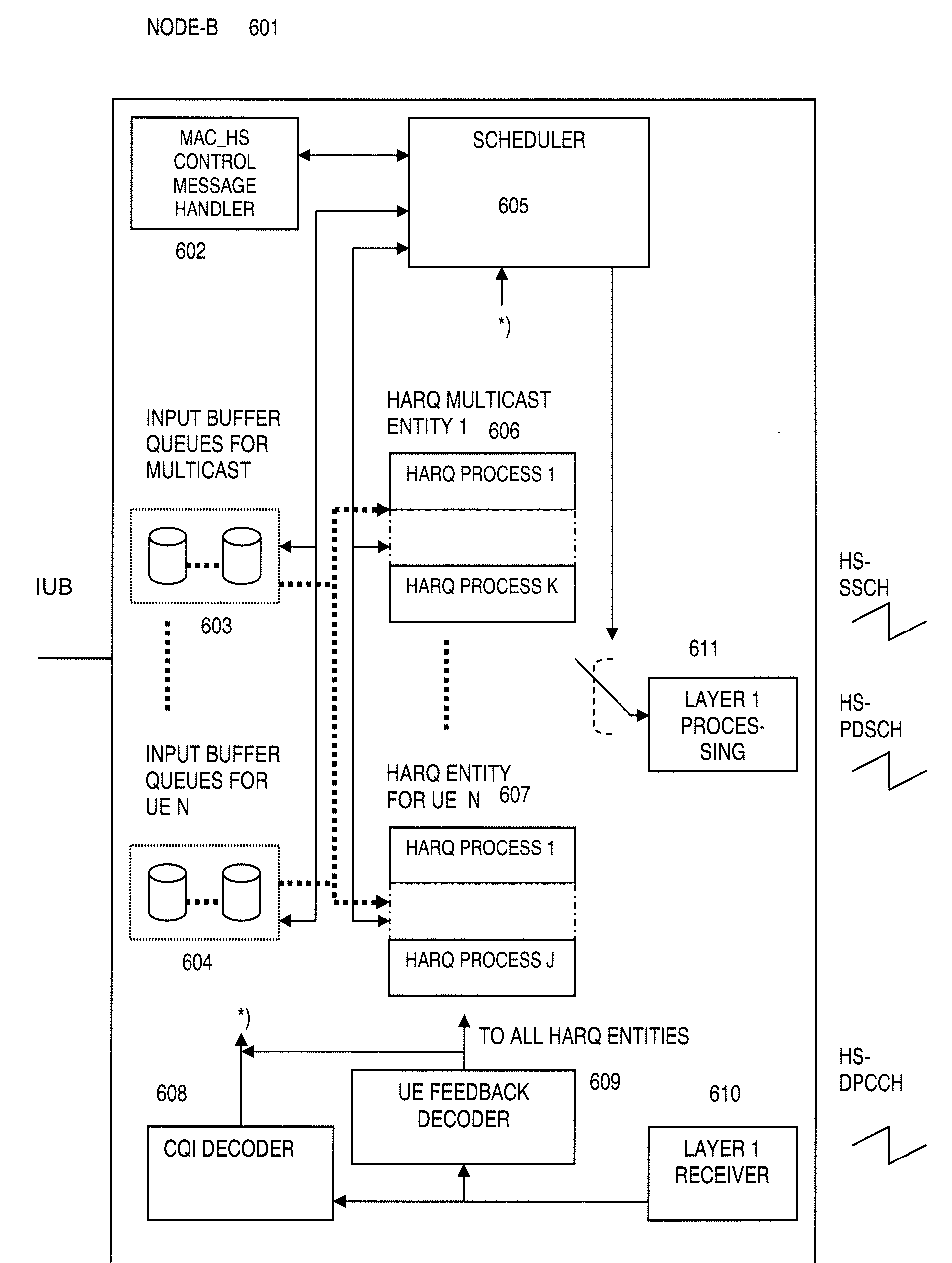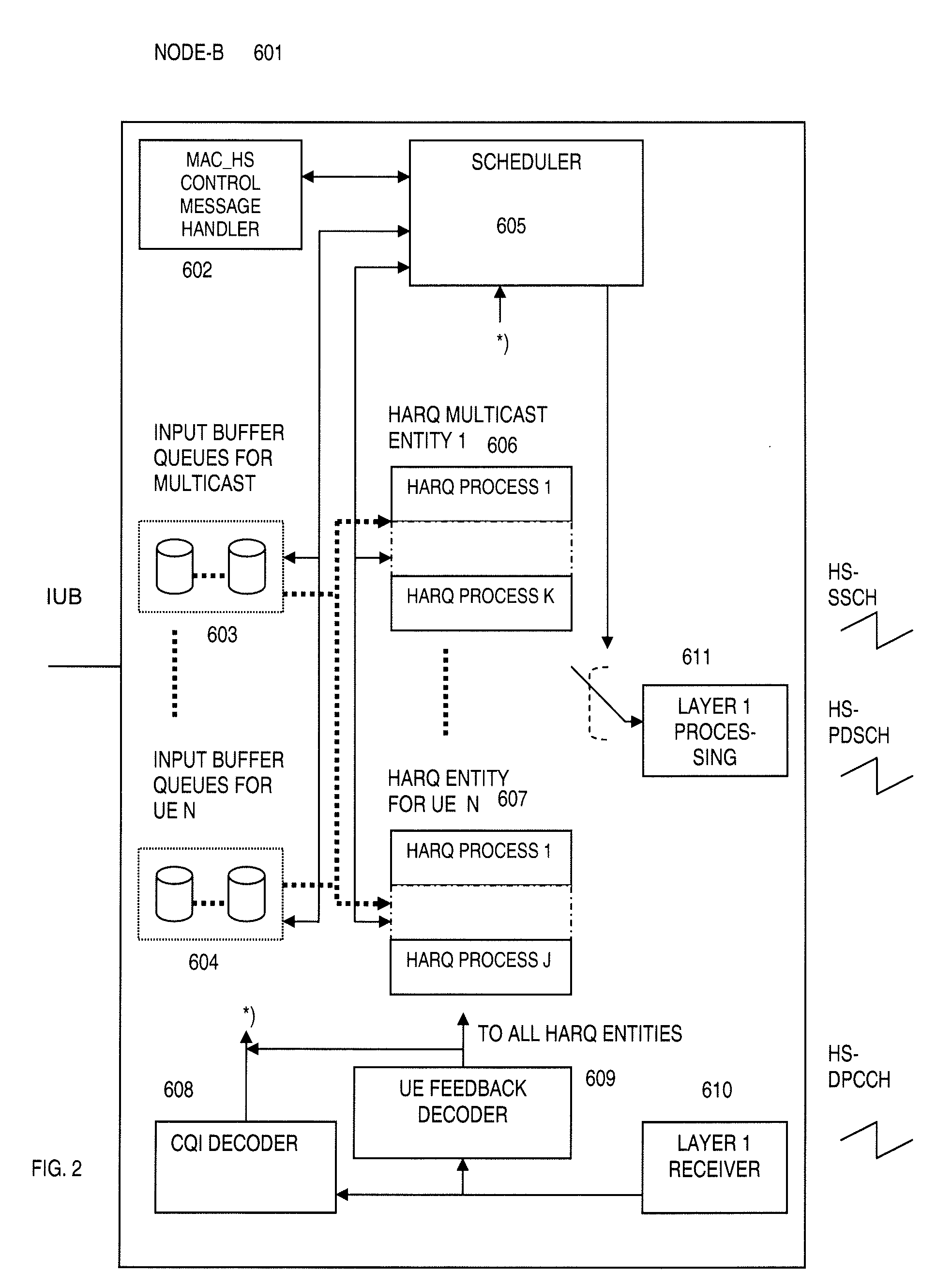Broadcast AMD Multicast On High Speed Downlink Channels
a high-speed downlink channel and multicasting technology, applied in the direction of broadcast service distribution, data switching network, assessment restriction, etc., can solve the problems of not providing re-transmission, hsdpa is not targeted, and the solution is very bandwidth-consuming
- Summary
- Abstract
- Description
- Claims
- Application Information
AI Technical Summary
Benefits of technology
Problems solved by technology
Method used
Image
Examples
embodiment 1
[0070]According to the invention, multicasting is introduced on the HSPDA radio access interface between the base station set and multiple user entities wherein, a particular multicast HSDPA UE address is introduced in parallel to the normal unicast address, for transmitting content to multiple users in at least one cell simultaneously.
[0071]In FIG. 2, a base station (Node B) according to all embodiments of the invention are shown.
[0072]The base station (node B) 601 comprises a MAC-hs control message handler 602, a scheduler 605, a number of input buffers 604 storing segments of data streams pertaining to individual user entities, UE1-UEn, corresponding to a number 1-J of HARQ processes 607 for handling simultaneous transmissions to several UE's, that is, for each user entity as well, Layer 1 processing means 611 for transferring data from respective HARQ processes. The base station moreover comprises a CQI decoder 608, a user entity (UE) feedback decoder 609 and a layer 1 receiver ...
first embodiment
Alternative
[0117]An alternative procedure for the multicast HARQ process in Node B may be carried out basically as shown in FIG. 5. However, according to this embodiment, Node B does not perform any MU_ID-UE_ID mapping.
[0118]In a typical network the working point of operation may approximately be
90%—ACK
9%—NACK
1%—DTX
[0119]It is observed, that it is more likely to receive a NACK than a DTX. According to this alternative embodiment DTX—indicated in box 13—is not used for determining whether a retransmission should be carried out.
[0120]In a given exemplary situation, Node-B does not need to know that UE_ID 44, 56, 63 are members of MU_ID=1. If for instance a transmission to MU_ID=1 occurs—then UE_ID 44 and 56 may transmit ACK whilst UE_ID 63 sends a NACK—Node-B will receive 2 ACK and 1 NACK and thereby assume that there was only 3 members of MU_ID=1 and retransmit. If on the other hand it receives 2 ACK and one DTX—it will assume that all user entities in MU_ID received the message. Tha...
embodiment 2
[0121]In the second embodiment of the invention, the same base station configuration is used as in the first embodiment of the invention.
[0122]In the user entity according to the second embodiment of the invention, instead of descrambling the CRC with several ID's—that is, various multicast identities and the unicast user identity in question—only one ID is used for a period of time. Suitably, only one HS_SCCH receiver is provided in the user entity. When multicast content is chosen, a switch is made to the multicast identity, MU ID, in the user identity UE ID for decoding the HS-SCCH channel; otherwise the user identity is used for decoding the HS-SCCH channel. Hence, the user entity design is comparable to a prior art user entity design except for the ability to switch ID for decoding either normal HSDPA downlink unicast data or one multicast reception group at a time.
[0123]The user entity acts as shown in FIG. 6, with the exception that only 202 or only 203 are used. Step 203 is ...
PUM
 Login to View More
Login to View More Abstract
Description
Claims
Application Information
 Login to View More
Login to View More - R&D
- Intellectual Property
- Life Sciences
- Materials
- Tech Scout
- Unparalleled Data Quality
- Higher Quality Content
- 60% Fewer Hallucinations
Browse by: Latest US Patents, China's latest patents, Technical Efficacy Thesaurus, Application Domain, Technology Topic, Popular Technical Reports.
© 2025 PatSnap. All rights reserved.Legal|Privacy policy|Modern Slavery Act Transparency Statement|Sitemap|About US| Contact US: help@patsnap.com



